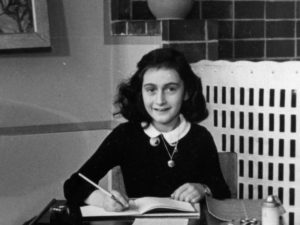
No one knows exactly when Anne Frank died in 1945, but we do know she was born on June 12, 1929. Every year, I remember how close I felt to her as an eleven-year-old reading The Diary of a Young Girl in a small closet in North Carolina. Anne was an intimate friend at a time when I had very few. Like so many girls, I completely identified with her nascent romantic and sexual longings, her hatred of her mother, her deep humanitarian, and her aspirations as a writer.
Four decades later, I had the joy of living in Amsterdam for six months, and discovered a distressing truth about that tolerant city: 80% of its Jewish people were rounded up and murdered. My child’s view that no one on earth could have suffered more than Anne was so wrong. She was much luckier than most. The Franks’ hiding place was ready in advance, they were all hidden together for 25 months, they had more room and comfort than most people (small as it was), and the quality of support from Miep Gies and others was extraordinary.
In 2002, while staying a few blocks from Anne Frank’s hiding place, I discovered that Jewish people had also been hidden in the attic above our apartment. When I learned that they were last seen fleeing over the rooftops as the Nazis shot at them, I had to learn more about the larger story of which Anne’s was only a part. I began imagining who those people were, and an historical novel began to take shape. For thirteen years, I read histories and memoirs; visited museums, archives, and libraries; listened to people who would talk with me; and wandered the canals looking for unmarked addresses where important events took place. That’s one of many reasons my book is called An Address in Amsterdam.
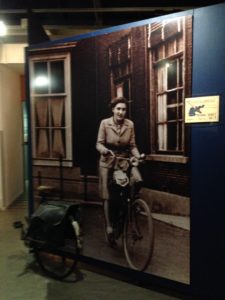
Resistance Courier at Verzetsmuseum, Amsterdam
As much as I regarded Anne with a child’s adoring eyes, and admired her with an adult’s greater discernment, I also realized that she was confined by her parents’ choices as well as the Nazi Occupation. She was not quite 11 when the Germans invaded the neutral Netherlands. If Anne Frank had been a few years older, it’s hard to imagine that she wouldn’t have found a way to help the resistance.
While I knew that my book would have a young Jewish woman as a heroine, I wanted to write about someone who was old enough to make her own decisions, but young enough that she would have to grow up fast in order to do so. How did an ordinary young woman decide to risk her life as a resister? What would she actually do, and how? As Rachel Klein, my heroine, formed in my imagination, I didn’t see her as an older Anne Frank, but as her own person, with different needs and ambitions than Anne. However, to be sure that I wasn’t unduly influenced, I avoided reading the Diary again until An Address in Amsterdam was done and in press.
As I re-read the Revised Critical Edition which compares all the versions of the Diary, I found my old friend Anne Frank still there – vulnerable, smart, fearful. Perhaps because the times had changed so much, I also heard more clearly than ever the warnings in her work, and her injunction to us now. Today, I’m not so much moved by the girl who wrote “I still believe that people are good at heart,” as the one who speaks to us now: “How wonderful it is that no one need wait a single moment before trying to improve the world.”

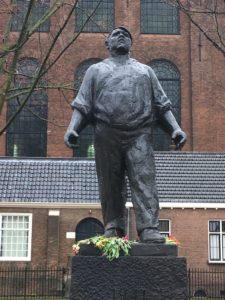

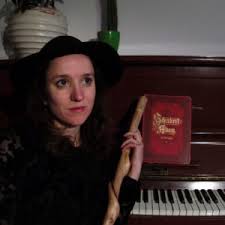



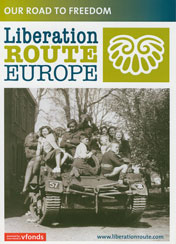 What a joy it was to meet Victoria van Krieken, the vibrant director of the
What a joy it was to meet Victoria van Krieken, the vibrant director of the 
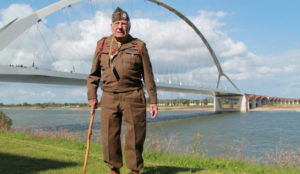 it is the last time “we will be able to honor the veterans in their presence.” Even if a few live until the 80th anniversary, there is no guarantee that they will be in a condition to participate. So this is the last opportunity for a certain kind of connection with the past – and to assure the veterans that future generations will continue to walk in their footsteps. Three big projects will support the anniversary effort: a multifaceted commemoration with an emphasis on involving people across countries, occupations and generations; an international awareness campaign; and completion of the Trail itself. How wonderful to imagine what this dynamic woman and her young staff will come up with to bring the past into the future! It is a “modern pilgrimage” as van Krieken puts it. People from every country will be welcome either to participate in person or in electronic ways that we can only begin to conceive of now. In either case, we won’t forget.
it is the last time “we will be able to honor the veterans in their presence.” Even if a few live until the 80th anniversary, there is no guarantee that they will be in a condition to participate. So this is the last opportunity for a certain kind of connection with the past – and to assure the veterans that future generations will continue to walk in their footsteps. Three big projects will support the anniversary effort: a multifaceted commemoration with an emphasis on involving people across countries, occupations and generations; an international awareness campaign; and completion of the Trail itself. How wonderful to imagine what this dynamic woman and her young staff will come up with to bring the past into the future! It is a “modern pilgrimage” as van Krieken puts it. People from every country will be welcome either to participate in person or in electronic ways that we can only begin to conceive of now. In either case, we won’t forget.
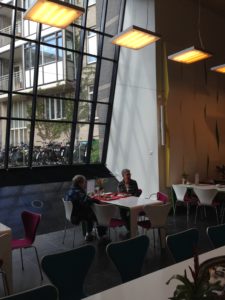
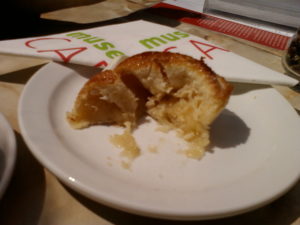

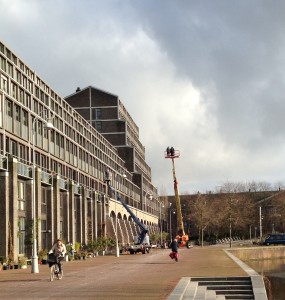
 These amazing daffodils came from “the other flower market,” held Monday mornings at the open square behind the Amstelkerk. Notice also the carved white marble support for the steps, the gauze curtain that gives a little privacy without preventing people from seeing in, the bicycle parked out front, the houseboat on the other side of the canal, and the big windows in the 17th century buildings. In the dark northern climate, the latter were essential to provide enough indoor light.
These amazing daffodils came from “the other flower market,” held Monday mornings at the open square behind the Amstelkerk. Notice also the carved white marble support for the steps, the gauze curtain that gives a little privacy without preventing people from seeing in, the bicycle parked out front, the houseboat on the other side of the canal, and the big windows in the 17th century buildings. In the dark northern climate, the latter were essential to provide enough indoor light.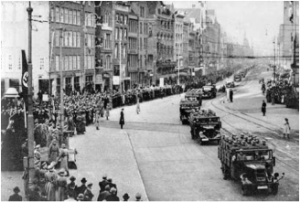 The German soldiers are rolling into Amsterdam in May 1940. If you look closely, you’ll see at least one person giving them the Nazi salute. The Dutch population was completely shocked by the invasion. They had believed and hoped that they could remain neutral as they had in World War I. Although the initial attack was by air, Rotterdam was the city which suffered most by far. Because of the surrender, Amsterdam was spared bombardment apart from a few accidents.
The German soldiers are rolling into Amsterdam in May 1940. If you look closely, you’ll see at least one person giving them the Nazi salute. The Dutch population was completely shocked by the invasion. They had believed and hoped that they could remain neutral as they had in World War I. Although the initial attack was by air, Rotterdam was the city which suffered most by far. Because of the surrender, Amsterdam was spared bombardment apart from a few accidents.